If you’re a camping fanatic or lover of the outdoors in general, there’s no doubt you’ll want the best backpacking tent possible to keep you cozy on any adventure. After all, this is your home away from home, so it needs to be comfortable and reliable in all kinds of weather!
In this article, I’m going to walk you through the ultimate backpacking tents to buy and give you tips on how to choose them.
The best backpacking tent should be lightweight, made of sturdy material, and fit snugly in your pack. It also helps if said tent is easy to set up and break down at a moment’s notice.
Generally speaking, good tents are pricey but fear not — these bad boys will be sure to last you a lifetime, especially when you take care of them.
So whether you’re planning a multi-day hiking adventure or just a weekend in the outdoors, this list of best backpacking camping tents will make sure that your long-term investment is a good one.
View Contents
Our Picks for Best Backpacking Tents (2024)
- Best Overall Backpacking Tent – MSR Hubba Hubba NX
- Best Budget Backpacking Tent – Kelty Salida
- Best Ultralight Tent – Nemo Hornet Ultralight
- Best for Winter Camping – Naturehike Cloud-Up 4 Season with Snowskirt
Backpacking Tents: Comparison Table
| Tent | Price | Capacity | Weight | Material | Seasons | Reviews |
|---|---|---|---|---|---|---|
| Mountainsmith Morrison 2 | $ | 2 | 4lbs | Polyester | PU2000mm Coating | 3 | Read Reviews |
| North Face Stormbreak 3 | $$ | 2 | 6lbs | 68D Polyester Taffeta | 75D Breathable Polyester | PU1500mm Coating | 3 | Read Reviews |
| Big Agnes Copper Spur HV UL | $$$$ | 1/2/3/4 | 1lb/3lbs/4.9lbs/5.8lbs | Ripstop Nylon | PU1200mm Coating | 3 | Read Reviews |
| MSR Hubba Hubba NX | $$$ | 2 | 3.4lbs | 20D Ripstop Nylon | 15D Nylon Mesh | 3 | Read Reviews |
| MSR Elixir | $$$ | 2 | 6lbs | 40D Ripstop Nylon | 68D Ripstop Polyester | PU1500mm Coating | 3 | Read Reviews |
| Nemo Hornet Ultralight | $$$ | 1/2 | 2lbs/2.1lbs | 10D Ripstop Nylon | 10D SilNylon | PU1200mm Coating | 3 | Read Reviews |
| Kelty TN 3 | $$ | 2/3/4 | 4.9lbs/5.3lbs/7lbs | 70D Nylon | 40D SilNylon | PU3000mm Coating | 3 | Read Reviews |
| Kelty Salida | $ | 1/2/4 | 3.9lbs/4.6lbs/7lbs | 68D Polyester | 68D Nylon | PU1800mm Coating | 3 | Read Reviews |
| GEERTOP 4 Season Double Layer | $ | 2 | 6.6lbs | Anti-Tear Polyester | PU 3000mm Coating | 4 | Read Reviews |
| Naturehike Cloud-Up 3P 4 Season With Snowskirt | $$ | 2/3 | 3.8lbs/5.2lbs | 20D Ripstop Nylon | Silicon Coated | PU4000mm | 4 | Read Reviews |
Why Use a Tent
While spending evenings in the great outdoors, it’s a good idea to use a tent.
Not only will it protect you from elements like wind, rain and intense sunlight, but it will also keep away pesky mosquitoes and any other wildlife that may come wandering onto your campsite.
A short story for all you curious readers: I used to spend my summers at an overnight camp in the United States. They would take us camping in Maine for one week every summer, which was a great time for all. Think swimming in rivers, hiking on trails, s’more and all around good wholesome fun.
Early one morning, we awoke to a scratching sound on the outside of our tent (mind you, we were 13 years old at the time, being supervised by 21-year-olds) and our camp counselors hushing us and telling us not to move. There was a huge shadow lurking outside our shelter and we realized that we had some company…
A bear was outside of our tent, scratching and roaming around the site.
We had absolutely begged the counselors to let us sleep under the stars the evening before but they insisted we needed proper shelter, and obviously for good reason! Without that tent, we would’ve been bear food.
Mister Bear eventually moved on to the dumpster behind the site and left us alone, but ever since then, I have insisted on using a tent whenever my friends and I take a trip to the great outdoors. (Okay, total disclaimer, a tent may not completely protect you from bears and other wild animals but it sure will deter them more than if you were just sleeping out in the open!)
I’m a huge camper and have spent many a summer (and winter) sleeping outside. While it’s tempting to just sleep under the stars with no shelter, you’ll definitely regret this decision when waking up covered in bug bites, a huge sunburn, or being towered over by a hungry bear.
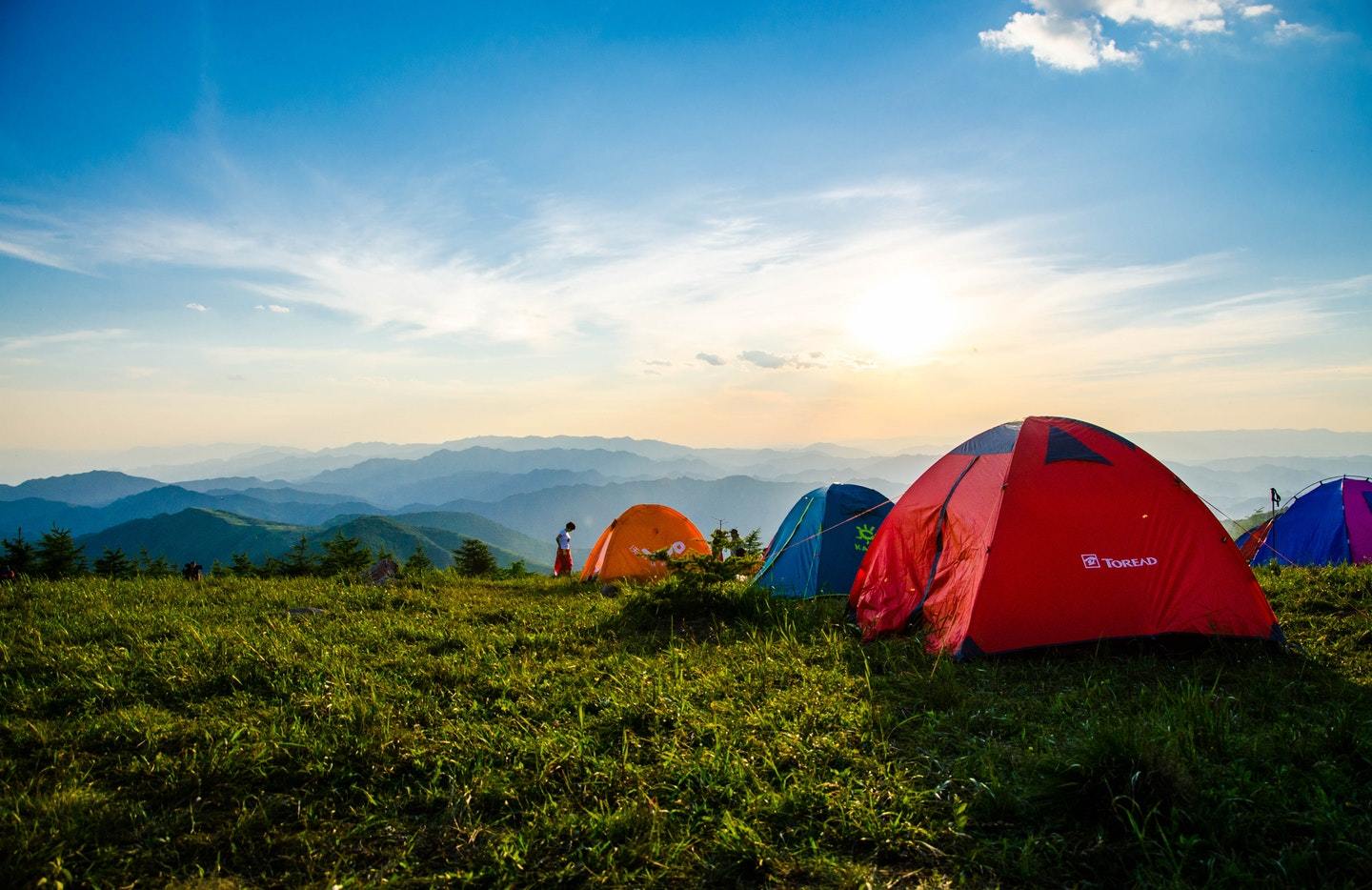
Psst...Want in on a Secret? 🤫
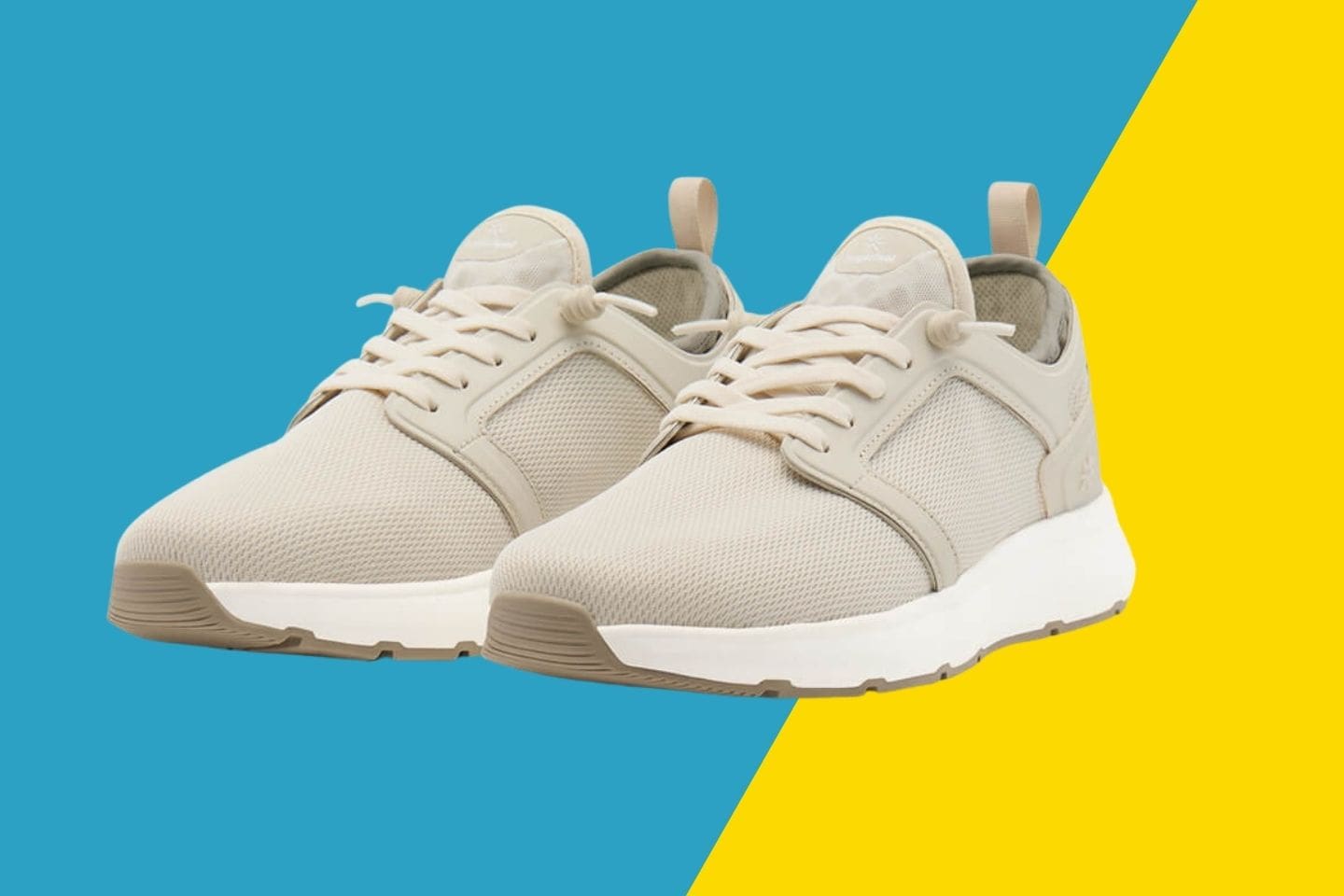
We've scoured the internet for the best ALL-AROUND travel shoe and Tropicfeel wins by far. We've taken ours through rivers, jungles, and cities and they're still alive and kickin'. Check them out below.
Different Types of Tents
There are tons of different types of tents to choose from.
Here are some main kinds you’ll find on your hunt for the best backpacking tent.
Single vs Double Wall
The main classification for tents is single or double wall.
Tents with a double wall are most popular, especially for backpacking, because they best protect you from the elements.
Double walled tents have two components:
- a main layer which is made from fabric and mesh
- an outside layer called a rainfly, that’s waterproof and protects you from the elements
Alternatively, single walled tents only have a (you guessed it!) single layer that acts as both the inner and outer waterproof layer. These are the most lightweight, but aren’t great for backpacking in different conditions.
Dome Tent
Dome tents are the most popular for backpacking as they’re a simple build and easy to set up. They’re made from arced poles which create a dome shape (hence the name) and have a spacious interior for sleeping and moving around.
Dome tents hold up well in wind and other weather because of their shape, but it’s important to also put up a rainfly in case you experience any unexpected weather conditions!
Geodesic Tents
Geodesic tents are in the same family as dome tents, just a bit bigger and more complex. These kind of tents have more poles to create an even stronger frame.
They’re better for harsher conditions, and are often used for winter camping or serious expeditions.
Tunnel Tents
Tunnel tents are less common but you’ll likely come across them when comparing different tent models.
They’re made from poles that create a U or hoop-shaped frame, which ends up looking something like a tunnel. They aren’t great in wind because of this shape, so you need to be careful where you pitch your tunnel tent.
How to Choose the Best Tent for You
Choosing the best tent means taking different factors into consideration. Here are 8 factors that will influence which tent is best for you.
Price
As always, it’s good to start by setting a budget.
Knowing how much you’re willing to spend on a backpacking tent will help narrow the pool and give you a smaller selection to choose from. That being said, it’s nice to have a flexible budget so that if you find one that really suits your needs, you can spend that extra few bucks on it.
Backpacking tents aren’t cheap, especially the ones that will last you for years to come. Keep that in mind when setting your budget and remember that more than anything, this is an investment.
Season Rating
Thinking about when you’ll use this tent is a critical consideration when picking a tent that’s right for you.
Most backpacking tents have a three-season rating which means that they can be used in spring, summer and fall while keeping you comfortable inside. Three-season tents can also be used (cautiously) in mild winter conditions as they can handle a little bit of snow.
That being said, for serious winter campers, you’re going to want a winter or four-season tent that can handle harsher conditions.
Three-season tents are a good place to start if you’re looking for a backpacking tent because there’s fewer limits to when and where you can use them.
If you’re a winter backcountry explorer, you’ll probably want a winter or four-season tent.
These tents are heavier because there’s less mesh, and are kind of a pain to carry around, but they’ll keep you cozy on the coldest days and ensure you’re properly protected from the winter weather. That being said, four-season tents don’t have as much ventilation and can actually end up making you colder because of increased condensation inside. Just something to think about.

Size and Capacity
Size is another critical consideration for a backpacking tent.
Look carefully to see how big the tent will be when pitched, and how small it will be when folded up and ready to be packed.
For backpacking, you’ll want a tent that packs up to be small so it doesn’t take up a lot of space in your pack. This is essential so that you can fit everything else you need, without struggling with space or weight of your backpack.
Along the same lines, you should think about tent capacity as well.
Is this tent only for you, or you and your significant other? Or would you rather have a tent that accommodates an entire party?
Smaller tents obviously fit fewer people but they’re lightweight, more practical for backpacking, and easier to carry. Larger tents are fun for bigger groups because everyone gets to sleep together, but get drafty if you’re using it on your own and can be a total pain to carry by yourself.
Be sure to look at the tent’s capacity before purchasing so that you can choose one that’s right for you and your backpacking needs.
Weight
Weight is one of the most important things to look for when choosing a tent. Tents can range from ultra lightweight to quite heavy.
If you’re planning on using the tent for standard camping trips without a ton of walking, a heavier tent will be just fine.
However, if this is a true backpacking tent and you plan on trekking and exploring the backcountry with it, you’re going to want the lightest one possible. The last thing you want is a heavy tent weighing down your pack on days jam-packed with adventure.
The weight of a tent greatly depends on the materials used for constructing it, but more on that below.
Materials
You’ll find tents made of a wide range of materials. The material a tent is made out of contributes to its weight and durability, making it an important consideration when choosing between different models.
Here are some main materials you’ll run into when looking at backpacking tents:
Polyurethane (PU) Coated Fabrics – Budget tents are typically made out of polyurethane coated fabrics. This fabric is reasonably durable, and waterproof as well. However, because it’s less expensive, it’s prone to chemical breakup which strips the fabric of its waterproof properties.
SilNylon – You’ll find SilNylon materials on high-quality tents as it’s very water-resistant and holds up well in a variety of climates and weather patterns. It’s strong, lightweight and durable, which is what makes it a top choice for backpacking tent material.
Essentially, silicon coats the nylon which makes it waterproof. Nylon is a durable and lightweight material making it ideal for the base construction of a tent. On less expensive tents, you may find nylon coated with silicon on the outside and polyurethane on the inside.
Cuben Fiber – Cuben fiber is the best material on the market for outdoor gear. Backpacking tents made of this material are the strongest, lightest, and most durable. They’re ultra waterproof and are made for a variety of climates.
A cuben fiber tend weighs half as much as tents made from SilNylon and is more weather and water-resistant as well. If you’re willing to spend the money on it, this is what you should go for. But be warned, it doesn’t come cheap.
When it comes to material, the last thing you want to look at is the denier. This is essentially a number followed by a D, and it indicates how thick the fiber of the material is.
The higher the denier, the more durable and sturdy it will be, while a lower denier will be more sheer and susceptible to rips and tears.
Set-up
The best backpacking tents should be easy and hassle free to set up and quick to breakdown as well.
Imagine getting to your campsite at dusk and having to set up your tent in the dark. You’re going to want something that can be set up in a jiffy so you can get to more important things — like roasting hot dogs and marshmallows!
Typically, free standing tents are the easiest to set up, while ultralight shelters take more time and care. Dome and tunnel sets have a quick set up because there aren’t too many poles and have a fairly easy structure. If set-up is a primary concern, go for one of these.
Doors and Windows
I highly recommend getting a tent that has more than one door and other ventilation areas as well.
If you’re going to be sleeping in a tent with more than one person, you don’t want to have to climb over each other to go for a quick toilet run in the middle of the night.
Having two doors on either side of the tent is ideal, with other mesh openings throughout to keep you cool on hot summer nights and allow for proper ventilation.
Another awesome opening on a tent is on the roof. Having a mesh top allows you to see the stars and get a cool breeze going. The only downside to this is if you want to utilize it, you’ll have to forego the rainfly — which isn’t advisable if you’re somewhere with unpredictable weather.
Footprint
This isn’t an essential part of a tent, but I highly recommend using a footprint whenever you’re camping. The footprint is a tarp that goes under the tent to offer extra protection from debris filled ground or wet soil.
Some tents come with a footprint, but most don’t.
It’s a good idea to buy a simple tarp to use as one. Measure it to be slightly larger than the bottom of your tent, or fold it up to be the size you need. You’ll be grateful when water doesn’t seep in from the ground while you’re sleeping!
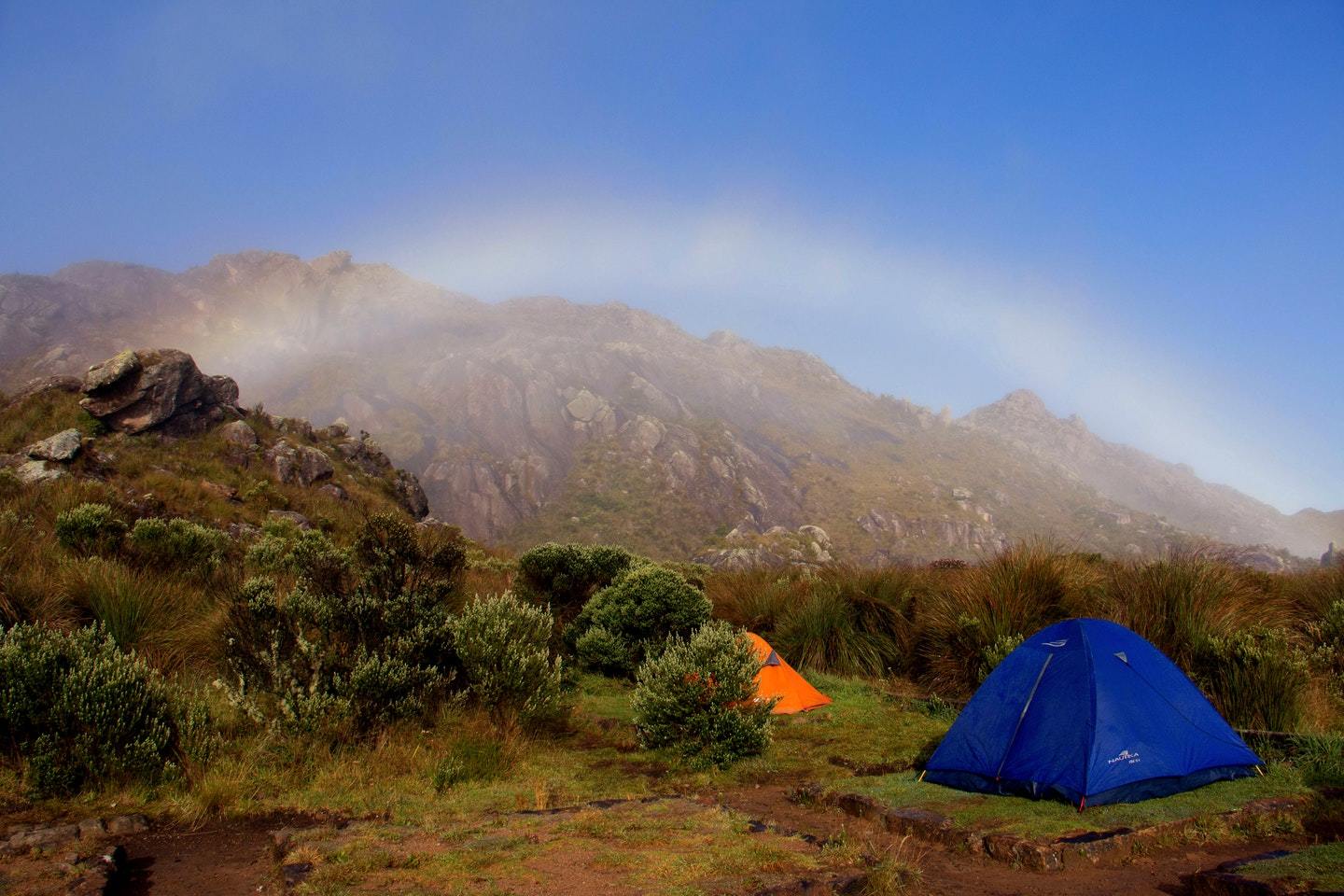
Best Backpacking Tents 2024
Now that you know what to look for in a tent, it’s time to choose the best one for your backpacking adventures. Here are reviews for 10 of our favorite tents in 2024 to help you find your next backpacking companion!
Mountainsmith Morrison 2
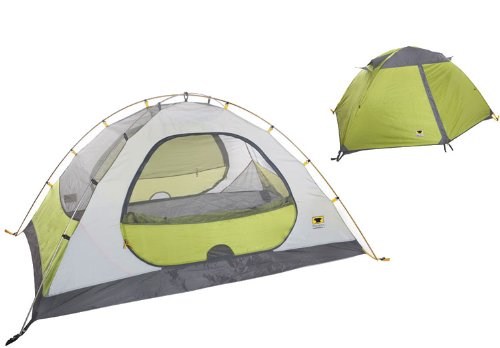
Dimensions (LxWxH): 92″ x 56″ x 43″
Doors: 2
Capacity: 2 Persons
Season: 3-Season
Kicking off our list of best backpacking tents is the Mountainsmith Morrison which sleeps two in its spacious and well-constructed design.
This tent is freestanding, which means it’ll be quick to set up and break down, plus it has two vestibules which will give you that extra storage space for sweaty or wet gear that you don’t want in your sleeping space.
The base is made with a bathtub floor construction, meaning that the bottom and lower sides are completely waterproof to keep you dry on those unexpectedly rainy nights. On nicer evenings, you can stargaze out of the mesh top or throw on the rainfly for some extra insulation when it’s cool.
There’s even a headlamp slot so that you can light up the interior of the tent when the sun goes down!
While this tent is a little heavier than the ultralight ones on the market, it’s fairly durable, with excellent ventilation and some pretty cool features which is why it’s ideal for the average backpacker.
North Face Stormbreak 3
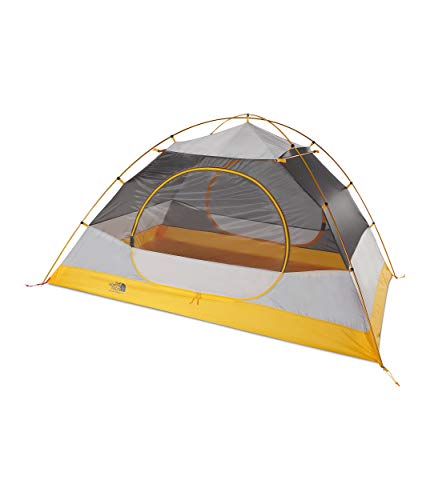
Dimensions: 88″ x 65″ x 46″
Doors: 2
Capacity: 3 Persons
Season: 3-Season
Outdoor gear powerhouse North Face does not disappoint with their Stormbreak 3 tent which is a great choice for any outdoor adventure.
With a freestanding design made from 75D polyester with a PU coating, this tent will withstand a wide variety of conditions and last for many backpacking trips to come.
Less expensive than other backpacking tents, you’ll find that the Stormbreak is super easy to set up and provides awesome ventilation for warmer evenings. The rainfly covers the entire tent and zips completely, protecting campers from wind and rain.
An awesome feature of this tent is that the doors are able to be stuffed into mesh pockets on the side, instead of having to roll them up every time you want to get in and out of the tent.
Similar to the prior tent, this is a little heavier than other backpacking tents, but with a five-minute set-up time and the ability to withstand high winds, it’s worth the extra weight.
Big Agnes Copper Spur HV UL

Dimensions: 90″ x 70″ x 44″
Doors: 2
Capacity: 2 Persons
Season: 3-Season
If you’re looking for a backpacking tent that’s lightweight and holds up in major storms, Big Agnes Copper Spur is a great option to consider.
Made from nylon and designed to be ultra lightweight, this tent is ideal for backpacking because it packs up small and won’t add excess weight to your pack. Besides the nylon construction, the lightweight nature also comes from specially-crafted aluminum poles that are designed to keep weight to a minimum while still being durable.
Users of this tent gush over the ability to keep water out on the rainiest days and nights, making for a stress-free camping experience. Not only will it keep you dry, but it’ll keep all your gear from getting soaked as well.
Another awesome feature is that the doors go almost down to the ground, making getting in and out of the tent easier than ever.
This tent is spacious for two people, meaning you could possibly fit a third, but beware of a tight fit if you do go for the extra person.
MSR Hubba Hubba NX
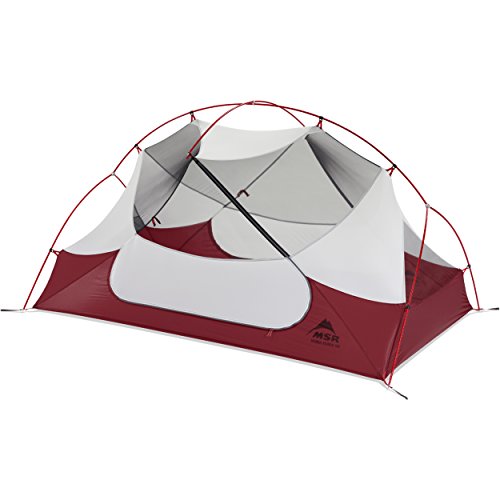
Dimensions: 84″ x 50″ x 39″
Doors: 2
Capacity: 2 Persons
Season: 3-Season
MSR killed the game with this tent, as you’ll feel like home when inside but feel like you’re carrying nothing when it’s in your pack.
Coming in at only a little over 3 pounds, this is an awesome lightweight, freestanding tent with a spacious interior and tons of protection from wind, rain, and chilly weather. When purchasing, you have the option to choose Xtreme Waterproof Coating, which last up to 3 times longer than standard waterproof coating!
Color-coded clips make for a super easy set-up, with users saying it only takes 2.5 minutes to put up and 5 minutes to break down and fold. Talk about time saving!
The tent is filled with spacious vestibules for storing gear and even one for stargazing on clear nights, making it a total fan favorite for backpackers across the globe.
For fitting in your pack, it comes with a compression sack, and its lightweight design and materials make it one of the best for taking along backpacking adventures.
MSR Elixir

Dimensions: 84″ x 110″ x 40″
Doors: 2
Capacity: 2 Persons
Season: 3-Season
A less expensive option than MSR is the Elixir.
It comfortably fits two people and has large vestibules that claim to offer 35% more space that other models. This tent comes with an adaptable rainfly that allows you to position it to see out while still being protected from the elements. How cool is that?
Besides all the standard features like being freestanding with two doors and having a spacious interior, the rainfly is ultra waterproof and offers maximum ventilation. While it may be a small detail, the zippers are glow-in-the-dark so you can always see what you’re doing without light.
This tent is about twice as heavy as the Hubba Hubba model, so it’s not the best for longer trips, but for a short backpacking trip, this will definitely do the trick.
Nemo Hornet Ultralight

Dimensions: 85″ x 50″ x 42″
Doors: 2
Capacity: 2 Persons (with 1-person option)
Season: 3-Season
Say hello to one of the lightest tents on the market!
Coming in at a tiny 2 pounds when packed, this tent is the ideal travel companion for long-term backpackers and those going on extended treks.
This two-person tent is excellent for rugged use as it’s made with durable materials and a thoughtful design. The floor of the tent is a true tub model which is ultra waterproof and scoops up, creating a waterproof edge around the entire bottom of the tent for any leaking water or runoff.
This is one of the only tents that’s 2 pounds and has two doors and two vestibules.
Besides being ultralight, there are additional features like a pocket for a headlamp on the ceiling, a single hubbed pole design for quick set-up, and a privacy panel.
There’s no doubt that this is one of the best backpacking tents out there.
Kelty TN 3 Person Tent
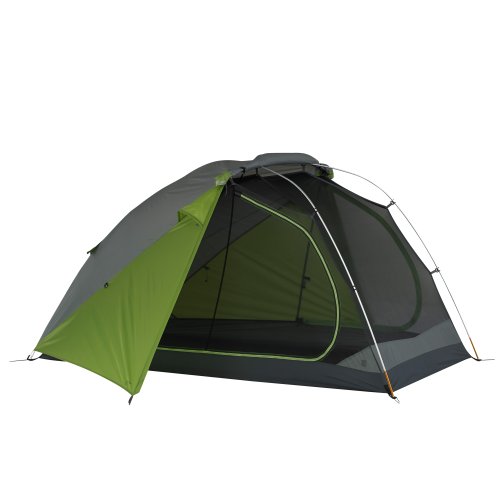
Dimensions: 85″ x 70″ x 43″
Doors: 2
Capacity: 3 Persons (with 2 and 4-person options available)
Season: 3-Season
For a three-person tent, just over 5 pounds is a total wonder in the weight department.
The Kelty TN 3 is a great choice if you’re traveling with a couple of companions, or a partner and a pup.
It folds up to be super compact, making it a breeze when it comes to fitting it in your backpack. What’s great is that its packability doesn’t sacrifice durability. Made from nylon and SilNylon, you’ll be protected from the elements, and will be able to use this tent over and over again with little wear and tear.
The best feature of this tent is the Stargazing rainfly that folds up halfway to allow you to see the night sky. While most tents would require you to completely remove the rainfly to catch a glimpse of the stars above, this one gets rid of that hassle!
An award-winning tent, there’s no surprise that the Kelty TN 3 makes our list of best backpacking tents in 2024.
Kelty Salida

Dimensions: 88″ x 55″ x 43″
Doors: 1
Capacity: 2 Persons (with 1 and 4-Person options)
Season: 3-Season[/column]
Another award-winning tent from Kelty, this budget-friendly option is great for a backpacking trip with a friend or two. In fact, it’s probably the best value-for-money backpacking tent out there!
Coming in three different sizes, you can pick up one for yourself, or one that will fit also your small backpacking group.
Made from 68D polyester, 68D nylon, and fully seam-taped construction, you’ll be cozy in any kind of weather with this bad boy. The Salida offers over 10 square feet of vestibule space, making it a great tent for storing gear, and it folds up to be quite small as any good backpacking tent should.
The top of the tent is mesh, making for awesome stargazing evenings, and the rainfly is angled which gets rain to run off instead of pool up. Plus, the standalone design and two-pole construction makes it super easy to set up and pack away.
A great option for budget backpackers looking for a durable tent!
GEERTOP 4 Season Double Layer
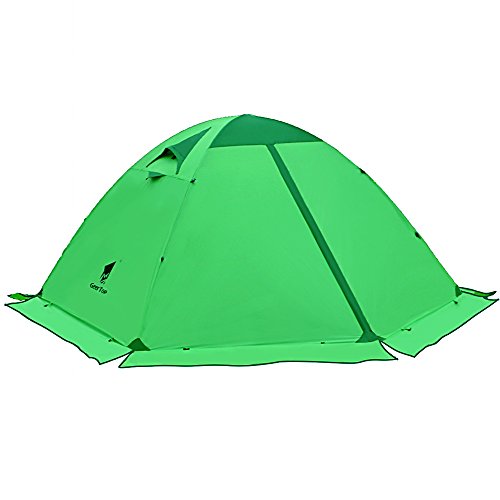
Dimensions: 94″ x 83″ x 53″
Doors: 2
Capacity: 2 Persons
Season: 4-Season[/column]
If you’re a budget backpacker looking for something you can use in sun, wind, rain and snow, this is the tent for you.
A low price doesn’t mean low quality in this case.
This is a durable four-season tent that fits up to two people, and will hold up for many years to come. The inner and outer layer of this tent superpose together to create a windproof seal, perfect for colder nights in the back country. On warmer evenings, use the inner layer alone for a ventilated sleep.
This tent features double stitched seams, as well as a 3,000mm water-resistant finish and UV blockage to boot. One of the best parts of this tent is that besides being super warm inside, the outer layer has a built-in snow skirt that will keep snow from creeping in as it will run off the slippery outside shell.
Plus, it’s only 6 and a half pounds!
The only thing to watch out for is condensation on the coldest nights, which is a concern not only with this tent, but with almost all winter camping tents.
It seriously doesn’t get much better than this tent, especially at this price point.
Naturehike Cloud-Up 3P 4 Season With Snowskirt
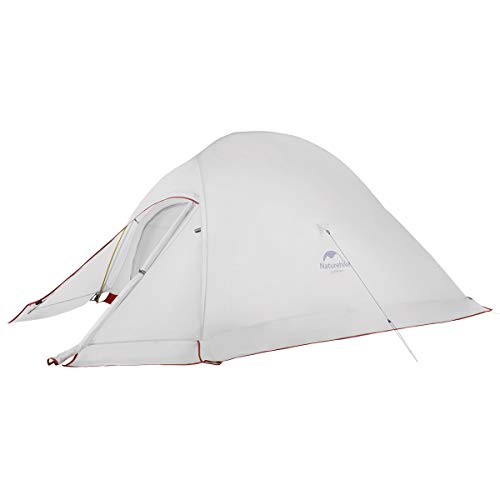
Dimensions: 85″ x 71″x 43″
Doors: 1
Capacity: 3 Persons (with 2-person option available)
Season: 4-Season[/column]
Finally, if you’re looking for one of the lightest four-season tents that sleeps three people out, you’re going to want to check out Naturehike’s Cloud-Up tent.
Weighing only 5 pounds including the outer layer and snow skirt, this tent is large and spacious but still cozy and lightweight.
You can use this tent in any kind of weather, and it’s built to last. It has a double layer, where the inner and outer layer come together to make a warm interior. When the inner layer is used alone, it’s well-ventilated and perfect for spring and summer camping.
The snowskirt is one of the best features of this tent because it will keep runoff snow from entering the tent. But this outer layer is also superior because it extends far past the tent’s entrance, shielding the door and opening from harsh weather.
Made from nylon and silicon, all the materials are ripstop, making the tent durable and long-lasting. The 4000mm PU coating only furthers this tent’s water resistance.
If you’re looking for a tent that you can take backpacking year-round, this may be the one for you.
Taking Care of Your Backpacking Tent
Taking care of your tent is the key to making it last for many trips to come. The last thing you want is a smelly, moldy tent just when you’re planning to use it.
To properly take care of your tent, you’re going to want to clean it and air it out after every use.
To do this, I recommend setting it up in your backyard (or wherever you can), and sweeping it out with a broom and dustpan. It’s also a good idea to brush out your tent before leaving the campsite to avoid bringing home excess dirt and debris.
Leave the tent up for a day (assuming the weather is good) with all the doors and panels open. This will air out the tent properly, getting rid of any backpacking smells that may be leftover from your trip. If there’s excess dirt or mildew in your tent, clean it out with warm soapy water and a cloth or brush.
Whatever you do, do not put your tent in a washing machine or get it dry cleaned.
A final tip: when packing up your tent, be sure that all the zippers are zipped up and you fold it with care. This will help maintain its shape, and make sure nothing gets snagged or ripped when you’re stuffing it away.
And don’t forget to double check to make sure you have all the poles and stakes!
Other Options for Shelter
If you’re looking for alternatives to a tent, there are a few other options for shelter in the outdoors. Here are some of my favorites.
Tarps
While it may seem counter-intuitive, tarps are actually the best for winter camping, in my opinion.
They’re extremely easy to set up and you won’t have to worry about condensation because they’re open on most sides. The A-Frame set-up is essentially designed to get snow to slide off instead of pool up, and they’re quick to pack up when you’re ready to go.
My biggest recommendation for setting up shelter with tarps is to practice beforehand!
While it may look easy and straightforward, you need to learn all the tricks for putting up this shelter. Only then are they easy and straightforward.
So watch some YouTube tutorials, practice in your backyard or a park, and learn your knots! The absolute last thing you want when you’re camping is to have a knot come loose in the middle of the night.
Hammocks
Another awesome shelter for camping or backpacking is sleeping in a hammock!
These days there are some amazing hammocks that even have built-in mosquito nets or attachable rainflys that allow you to perch in a tree and get a good night’s sleep, while being protected from all bugs and the elements.
The best thing about using a hammock for shelter is that they’re ultra lightweight and incredibly packable. This is a great choice for weight and space-conscious backpackers.
Here are some awesome hammocks to take backpacking with you:
- Hennessy Hammock – Ultralite Backpacker Series
- Lawson Hammock Blue Ridge Camping with Rainfly and Bug Net
- Clark NX-270 Four Season Camping Hammock
Bivy
Last but certainly not least, you’ve got your bivy bags.
Bivies are for the most intense backpackers (in my opinion) who are willing to brave the elements in the rawest form.
These are essentially big bags that go over your sleeping bag and encapsulate you completely. With a bivy, you can basically just find somewhere dry to sleep, unroll your sleeping bag, crawl into your bivy and voila! You have shelter for the night.
Bivies are pretty cool, except for a couple things.
One, when you zip them all the way up, your face is protected, but it may be pretty hard to breathe in there. There are some bags that have a mechanism to keep the bivy off your face, but with others, you’re pretty much a mummy.
Second, if you do get caught in rain or snow, you’re definitely in for it. Although many bivies are waterproof, my friend told me a story about winter camping with only a bivy and he woke up buried in about a foot of snow.
Great story, definitely uncomfortable experience digging yourself out first thing in the morning. But that just goes to show how warm these things are.
All of this being said, bivies are a great addition to winter camping gear, especially when using a tarp as a shelter. They’ll keep you extra warm and greatly reduce moisture, making them ideal for cold weather expeditions.
Here are some great bivy bags to consider:
For more recommendations, check out our guide to the best bivy sacks!
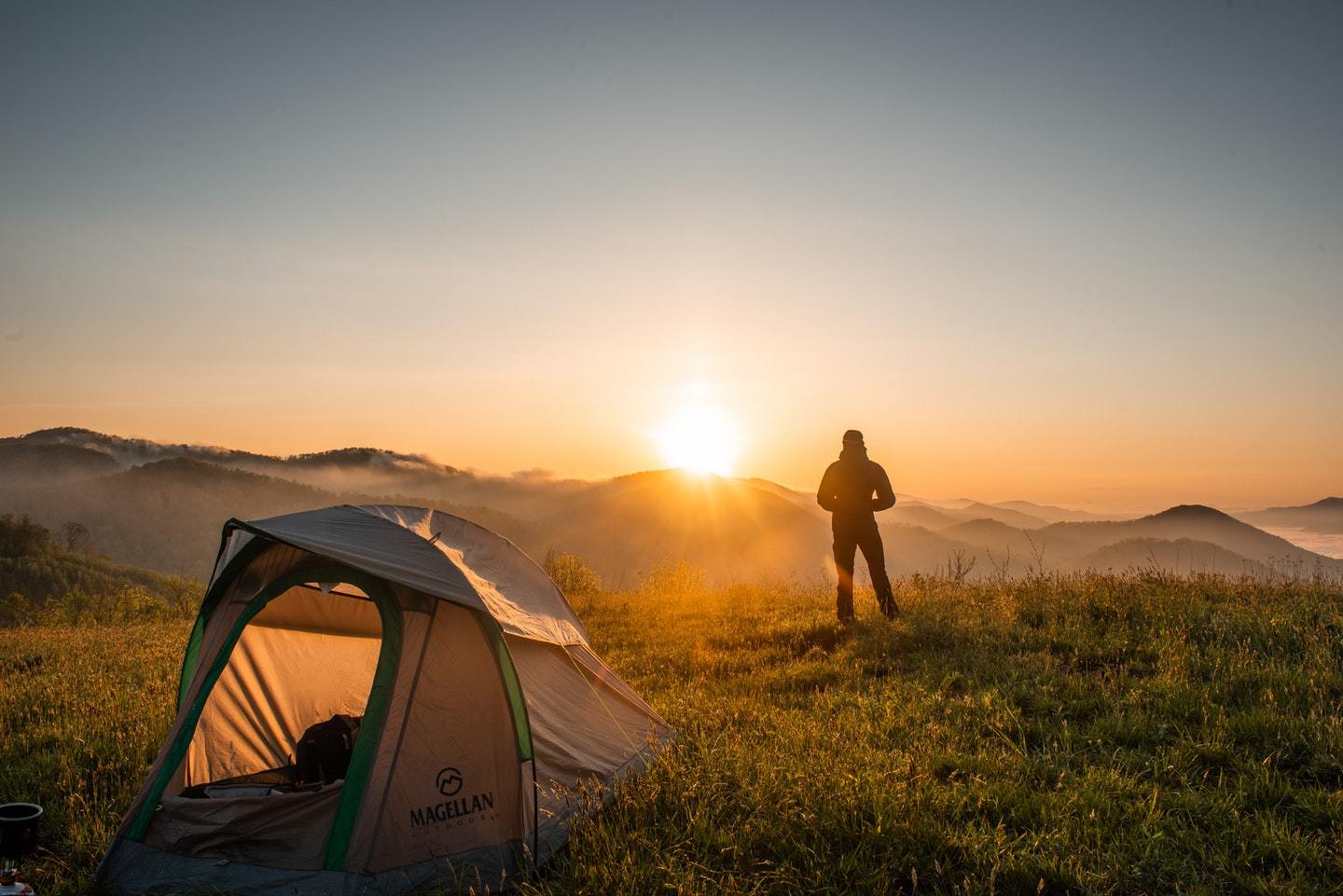
Hopefully after reading this article and our reviews, you have a better idea of some of the best backpacking tents available right now!
Always remember to take proper precautions while backpacking, especially in more remote areas. Pack light, have a good time, and roast a hot dog (or two) for me.
To help keep your pack light, be sure to check out our complete camping packing list, and if you’re on the hunt for a new pack to store your tent in, be sure read our complete guide to picking the best travel backpack.
Happy backpacking!
Getting ready for an outdoor adventure? Read our gear guides!
- Best Women’s Hiking Boots: The Ultimate List
- Best Men’s Hiking Boots: Boots for Any Outdoor Adventure
- Ultimate Guide to the Best Hiking Pants for Any Season
- Ultimate Guide to the Best Travel Cameras
Inspired? Pin it!
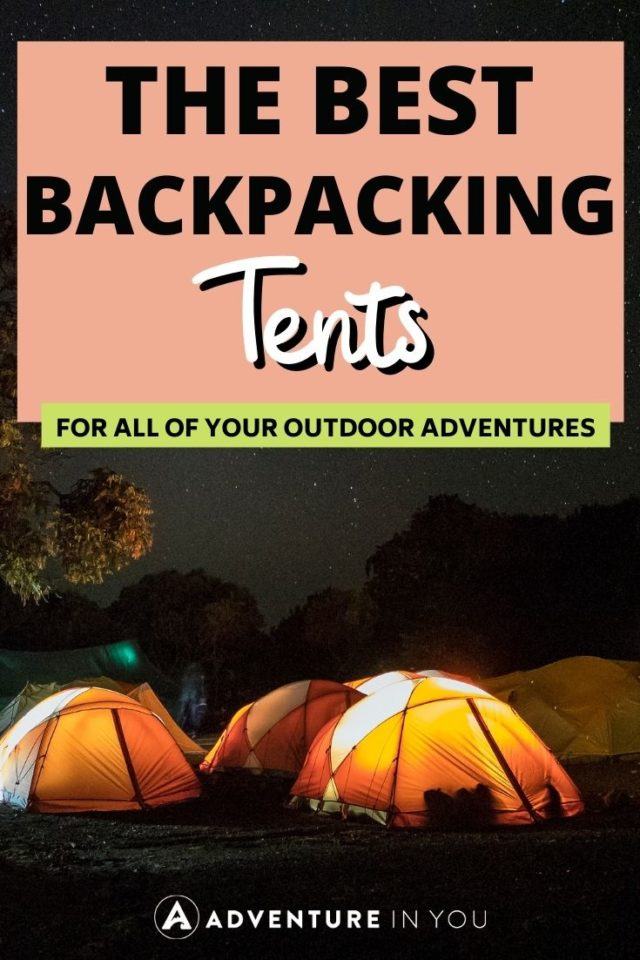
Very Nice Post. Lightweight tents is the necessity of every traveler that will help us to enjoy more and explore more. Thanks for such a great information/